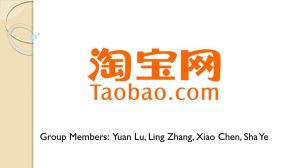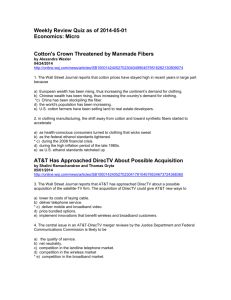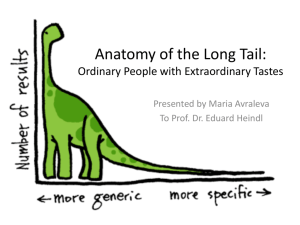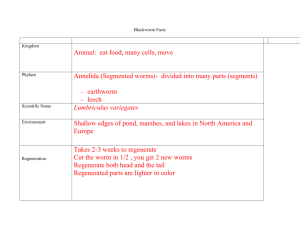The Double 11 Phenomenon in China
advertisement
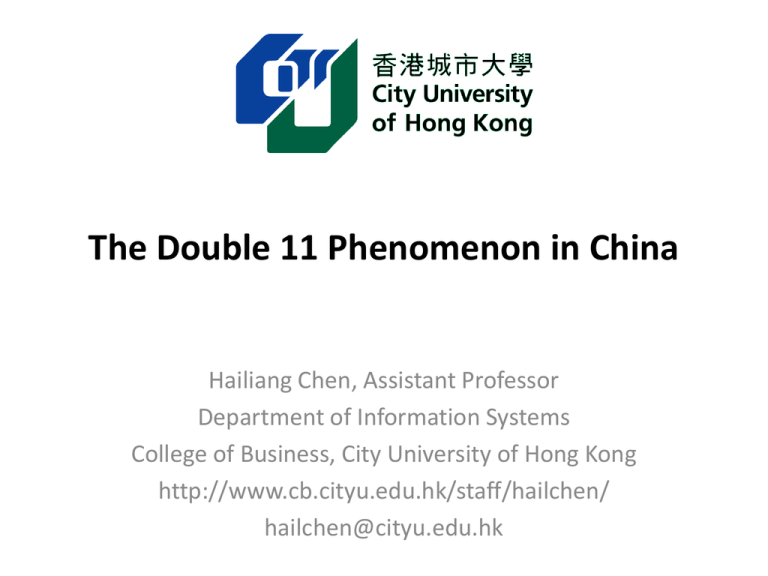
The Double 11 Phenomenon in China Hailiang Chen, Assistant Professor Department of Information Systems College of Business, City University of Hong Kong http://www.cb.cityu.edu.hk/staff/hailchen/ hailchen@cityu.edu.hk Agenda • • • • What is Double 11? Data Price/Sales Levels Long Tail What is Double 11? • Origin of 11/11 Double 11 is a web shopping festival created by Taobao, the China’s largest ecommerce platform. The concept of the “Singles Day Shopping Spree” was first introduced by Taobao in 2010. The leading factor for customers to purchase on this day is the big discount. On Double 11, as advertised, a large amount of merchants have discounts, big and small. The most attractive part for customers is Tmall’s allhalf-price event. Therefore, lots of customers wait to purchase on this day. • Historical sales 2009: (only 27 brands) 50 million Yuan. 2010: (150 brands) 936 million Yuan. 2011: (2000+ brands) 5.3 billion Yuan. 2012: 19.1 billion Yuan. 2013: 35 billion Yuan. Data • Data introduction 1. 2. 3. 4. Daily transaction data of Taobao and Tmall 30 days’ transaction from 2011.11.1 to 2011.11.30 Each piece of data is one transaction Total 12,562,195 pieces of data. • Data type 1. Product information ( ID, Price, Category) 2. Transaction information ( Quantity, Date) Price & Sales Levels on 11/11 Compare the sales performance of the products on“Double-11”and normal day Price Ratio = Average Price on 11-11/ Basic price Sales Ratio = Total sales on 11-11 / Basic sales Table1:Brief Summary of Price Ratio and Sales Ratio Variable Price Ratio Sales Ratio Num of Samples Avg Min 256,273 0.980 0.000 200 0.424 256,292 2.356 0.001 1196 7.598 Max Std Price Distribution on 11/11 226270 • 9.7% of products are on sales, most of them took 50% and 10% discount. • 4.7% of products raised their price, but the increments were small. • Other 85.6% of products sold on their original price. Sales Distribution on 11/11 • 61.7% of products sold as many as or less than normal daily sales. • 34.9% of products’ sales were 1 to 10 times of their normal daily sales. • 3.4% of products sold more than 10 times of their normal daily sales. Long Tail and 11/11 Does the long tail phenomenon exist on Tmall and Taobao? How does the 11/11 phenomenon affect the shape of the tail? 11/11 Tmall Taobao Long Tail 8 Long Tail and 11/11 Long Tail Ecommerce market Sales Popular products Traditional offline market Positive sales for niche products in the online market Popularity Niche products 9 Long Tail and 11/11 Higher or lower? Positive sales for niche? Product Variety Concentrated on popular products? Sales Distribution Hypothesis Testing How much does top 20% popular products contribute? 10 Long Tail and 11/11 Table: Product Variety #products sold Tmall Taobao Both 11/30 11/11 November 20,608 88,235 213,715 201,408 265,814 2,577,085 222,016 354,049 2,790,800 • More products sold on 11/11: an increase of 59% 11 Long Tail and 11/11 Table: Product Variety #products sold Tmall Taobao Both 11/30 11/11 November 20,608 88,235 213,715 201,408 265,814 2,577,085 222,016 354,049 2,790,800 • More products sold on 11/11: an increase of 59% • More prominent on Tmall: an increase of over 300% (Taobao: 32%) 12 Long Tail and 11/11 Table: Sales Distribution Sales by top 20% products Tmall Taobao Both 11/30 11/11 November 71.3% 83.0% 87.4% 57.5% 63.1% 79.3% 59.5% 77.5% 81.2% 11/30: • Long Tail exists on both Tmall and Taobao • Longer tails on Taobao: Taobao sellers focus more on niche products, but Tmall sellers focus more on popular products 13 Long Tail and 11/11 Table: Sales Distribution Sales by top 20% products Tmall Taobao Both 11/30 11/11 November 71.3% 83.0% 87.4% 57.5% 63.1% 79.3% 59.5% 77.5% 81.2% 11/11: • Both Tmall and Taobao focus more on popular products on this day • Tmall sellers are almost like traditional offline sellers • Sales on 11/11 distorts the tail shape for the entire 14 month
